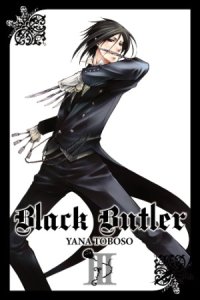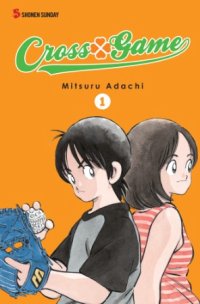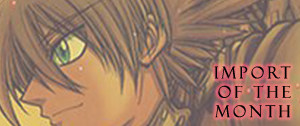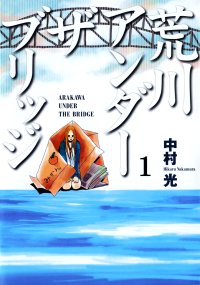RIGHT TURN ONLY!!
Cross Your Heart
by Carlo Santos,

When I likened the season of the 2010 San Francisco Baseball Giants to the plot of a shonen sports manga, I was just fooling around. Really.
I never imagined they would make it all come true.
The Giants' World Series championship is for all of us who have ever been told we weren't good enough. That we were too weak, too slow, too stupid, too untalented. When the experts pick against us, when they say we lack whatever-the-hell-it-is, that's the moment when one's true heart is revealed—when one proves that superior passion can, and will, beat superior talent.
When moments like these happen in fiction, it is inspirational.
When moments like these happen in real life, it is unforgettable.
BLACK BUTLER

Vol. 3
(by Yana Toboso, Yen Press, $10.99)
FROM THE BACK COVER:
"Terrorizing its populace, Jack the Ripper has shaken London to its very core. But when Sebastian Michaelis, singular butler of the Phantomhive house, lays bare the madman's true identity, all that is left for him to do is eliminate the perpetrator in the name of the Queen and Phantomhive. But inhumanly efficient skills don't guarantee victory when the opponent is just as supernaturally gifted! And though Sebastian may be able to save Ciel from physical harm in the battle that ensues, will the young earl ever recover from the emotional scars it will leave on his heart?"
EVIDENCE FOR:
Some fall in love with Black Butler for its sense of time and place—jolly olde England, in the heart of the Victorian era—but the real draw, perhaps, is the way it evokes such strong contrasts from that period. There are moments of incredible beauty, like the funeral scene with its ornate church setting and finely dressed aristocrats, coming just moments after unspeakable horrors like arms getting sliced and bloodshed in the London alleyways. The wide emotional range also has its pull: the flashback to Jack the Ripper's past is a shocking litany of tragedies, the kind that just breaks your heart, and yet the last chapter in this volume is a full 180-degree turn with its comical 19th-century romp through the woods. Yet the many dimensions of this story are all made enjoyable through Yana Toboso's style and pacing, which gets all sharp and savage and action-packed during the long extended fight with Grelle (and what a character, with that amusingly anachronistic chainsaw!) but turns the volume down with delicate lines and flowery ornamentation during quieter scenes of 19th-century life. Just like the title character, Black Butler truly does it all.
EVIDENCE AGAINST:
Big contrasts may be what make the series shine, but those highs and lows do have one thing in common: a shallowness that keeps the story from being genuinely effective. The battle between Sebastian and Grelle ends up dragging on way too long, with the two of them trading empty taunts and threats as if this were some angry dinner conversation instead of a fight for one's life. If they'd actually fought with clever, elaborate attacks, instead of just leaping about and making flashy stab-stab-stab moves while yelling at each other, this might have been an engaging fight, not 60 pages of noisy action. Similarly, the last couple of chapters rely too much on idle conversation instead of really exploring the emotional aspects of Ciel and Sebastian's existence; somehow it always takes five pages to express a sentiment that should only take one ("Protect me, you fancy black-suited butler!"). Even the most poignant part of this volume—the Jack the Ripper flashback—somehow extends past being a heartbreaking pause and becomes more of a "How much longer until we get back to the action" affair. Too many panels, my dear Toboso. Too many panels.
FINAL VERDICT:
This is probably just one of those series where I can see why people like it, yet it has yet to sink its hooks into me. The up-and-down-and-roundabout storytelling garners this volume only a C+ for the overall experience.
CROSS GAME

Vol. 1
(by Mitsuru Adachi, Viz Media, $19.99)
FROM THE BACK COVER:
"Cross Game is a moving drama that is heartfelt and true, yet in the brilliant hands of manga artist Mitsuru Adachi, delightfully flows with a light and amusing touch. The series centers around a boy named Ko, the family of four sisters who live down the street and the game of baseball. This poignant coming-of-age story will change your perception of what shonen manga can be."
EVIDENCE FOR:
The highest praise always goes to stories that work as fully-functioning universes, where characters don't just experience individual plotlines but entire lifetimes. And while Cross Game may not be a fantastical generations-spanning epic, it still manages to be a whole world unto itself, with Ko and his friends not just living out their "school days" or "baseball dreams" but youth in all its dimensions. That's why this triple-sized omnibus is worth the 572 pages: Volume 1 is surprising with its youthful romance that curveballs into heart-rending tragedy; Volume 2's time-skip advances to the hope-filled cusp of adolescence where a boy realizes his true talents; Volume 3 brings in a fierce adversary that adds fire to this school sports drama. And it's not just the range of moods and storylines that is impressive; it's the variety of characters, from sweet, sentimental Wakaba to the scheming, Steinbrenner-esque varsity coach to our own flaky-but-promising hero Ko. Adachi's fluid touch with a pen makes the artwork shine in many ways, from the simple, appealing character designs to the calming suburban backgrounds and the well-balanced pacing. This is hardly just a sports manga or school manga or shonen manga. It's life manga.
EVIDENCE AGAINST:
For a series that tries to be all things to all people, Cross Game has strangely missed a very important point: the game of baseball. In three volumes, the story only manages to trot out a couple of sandlot games, clearly not the kind of high-tension sports drama one might have been expecting. The rest is taken up by training scenes and decompressed slice-of-life languor, which may leave more restless readers wondering where the story is if it's supposed to be so great. Just look at filler chapters like the one about the robber, and the New Year's Eve episode, which Adachi most likely did as throwaway material in order to meet a deadline. And the characters, while varied, sometimes suffer from being one-dimensional in construction: a supporting cast of goof-offs and delinquents and sneering villains and daffy old men, it seems. And maybe that's where the series falters—it's actually too true to life, so much so that there can be long stretches of nothing and people you wish you hadn't met. Just like in the real world.
FINAL VERDICT:
Don't let words like "decompressed" and "slice-of-life" and "baseball" scare you off. This is just a darn good story with lots of charm and a deserving B+ grade.
FAIRY NAVIGATOR RUNA

Vol. 2
(by Miyoko Ikeda and Michiyo Kikuta, Del Rey, $10.99)
FROM THE BACK COVER:
"Runa bids farewell to her childhood friends and sets off on a quest to find the Jewel of Everlasting Time. Together with Mokke and Suneri, she travels to a beautiful port town—and finds herself in the middle of an ancient legend involving a magic crystal ball and merfolk!"
EVIDENCE FOR:
Fairy Navigator Runa may have gotten off to a painfully average start, but the second volume shows definite possibilities for redemption. Right away, this installment fearlessly turns the plot in a new direction—Runa leaves all her school friends behind in an emotional jaw-dropper, choosing to follow her destiny rather than the more comfortable route. Her encounters with new friends Shizuku, Ryô and Yui also turn out to be a more complex web of relationships than imagined, with twists and surprises that keep the reader guessing. Anyone who thought this was going to be a fluffy "Lalalaaa let's all be friends and fight evil together" adventure is in for a shock, as deception and negative feelings start to run high (especially in the later chapters). In fact, the cliffhanger right at the end of the volume is easily the best part of the series so far, with all the multiple plot threads, villainous factions and enchanted forces colliding in one intense moment of reckoning. More than just a magical fantasy quest, this is shaping up to be an honest-to-goodness thriller.
EVIDENCE AGAINST:
It's hard to imagine anything genuinely thrilling about a series where even the toughest bad guys look like they'd be more appropriate as huggable plush toys. Yes, the cutesy character designs and charming aesthetics may be great for pulling in younger readers, but when it comes to conveying anything with a dark atmosphere—as this story is starting to develop—the cream-puff artwork is no good. It doesn't help, either, that there are screentones all over the place being used as distractions to cover up horrible background work. (Then again, maybe Michiyo Kikuta should keep doing that, because when she is forced to put backgrounds out there, we get things like the world's most unrealistic apartment block.) It's also hard to feel invested in the characters when they all have the same watery eyes and stiff faces, with only hairstyles and heights to help tell them apart. Maybe it's some kind of fairy magic where everyone is cloned from the same template? For all the forward leaps this volume makes in the story, if the art continues in the same flat and awkward style, it'll never be a convincing adventure.
FINAL VERDICT:
Although it tries to dig into heavier material with Runa getting embroiled in mermaid-legend intrigue, the overall result is still too lightweight to merit anything higher than a C-.
NARUTO

Vol. 49
(by Masashi Kishimoto, Viz Media, $9.99)
FROM THE BACK COVER:
"Naruto is a young shinobi with an incorrigible knack for mischief. He's got a wild sense of humor, but Naruto is completely serious about his mission to be the world's greatest ninja!
As the five leaders of the strongest villages in the ninja world meet to discuss the fate of their universe—and how to deal with the ever-looming threat of the rogue organization, the Akatsuki—plans are made that will affect Naruto deeply. The new Hokage, leader of Naruto's village, is not afraid to make the final end move against Naruto's old pal, Sasuke!"
EVIDENCE FOR:
Hey, just because Naruto finished fighting Pain and saved Leaf Village from total destruction doesn't mean that the excitement has left this series. In fact, the Gokage Summit offers new sorts of tension and conflict, this time of the political variety, as different philosophies collide around the boardroom table. Every character has a motive, and every motive brings new complexities to the plot. Can the hot-tempered Raikage keep his emotions in check long enough to make a wise decision? Can the summit's senior members bring themselves to see eye-to-eye with young, idealistic Gaara, who has strong opinions of his own? Can Danzo, the new Hokage with illusory powers, even be trusted? It's that kind of gamesmanship that keeps this storyline bubbling. And just when the debate starts heating up, a sudden interruption brings back the physical element, with Sasuke's faction engaging in a head-on brawl that promises surprising new attacks and ever-vibrant visuals from Kishimoto's pen. If you thought Naruto's pals had skills, just wait until the Gokage representatives (all of whom are a triumph of ornate character design) show off their stuff. The excitement isn't gone—it just takes new form and thrills us all over again.
EVIDENCE AGAINST:
If this kind of poorly-planned chaos is what passes for excitement, then please, let me go back to sleep. Just as one might have expected from a political conference, the Gokage Summit is plagued by too many characters on the scene at once, chattering in lofty-sounding words and phrases that cloud the essential conflict lying underneath. Even if the characters are distinctively designed, the sheer number of them in a single scene (five leaders plus two retainers each) often leads to overload, as seen in the crowded panels filled with talking heads and buckets of dialogue. The switch to an all-out brawl in the later chapters doesn't help much either, because all it leads to is too many people fighting at once, with the action constantly jumping from scene to scene—often at just the wrong moment. It's hard to feel involved in a good fight with all these choppy transitions; Naruto's plot-revealing chat with the insidious Uchiha Madara would be a lot more compelling if it didn't keep cutting in and out of the Raikage's battle. This volume may be setting up the next great story arc, but it does so with a lot of noise and clutter.
FINAL VERDICT:
An intriguing and essential block of story, but it just isn't woven together very well; this latest round of orange-jumpsuited ninja action will have to content itself with a C.
THE STELLAR SIX OF GINGACHO

Vol. 1
(by Yuuki Fujimoto, Tokyopop, $10.99)
FROM THE BACK COVER:
"Mike, Kuro, Iba, Q, Sato and Mamoru star as the Stellar Six, the children of various store owners of the Galaxy Street's shopping district. Once inseparable childhood friends, they find themselves falling out of touch. But when a store on their home turf falls victim to vandalism, the Stellar Six come together again to help out, remembering the roots they share and the bonds that keep them close. In this story of true friendship, six best friends learn the importance and power of growing up together."
EVIDENCE FOR:
What would you do if I sang out of tune...? Yes, of all the things, Stellar Six is most like a manga version of The Wonder Years, with its rose-tinted view of young adolescence. Heck, it even comes with a grown-up first-person narrator telling parts of the story. As a result, it's older readers who will probably best understand the warmth and nostalgia of the series—the ineffable joy of goofing off with childhood friends, the memories built together, even the delicate moments when boys start to notice they are boys and girls start to notice they are girls. The variety of characters also comes as a pleasant surprise, not just in terms of personality, but also visually—different faces, different body types, different walks of life. There may be six of them, but learning to tell them apart comes quickly and easily. The long chapters also give each story room to grow organically: room for back-story, room for relationships, room for action, room for comedy, and room to capture your heart. With the delicate linework and soft gradients that grace each page, this portrait of youth reminds us that you can get by with a little help from your friends.
EVIDENCE AGAINST:
You know what happens when manga-ka are allowed to work with long chapters? The stories get rambly. Each of the offerings in this volume could have benefitted from some editing: the Granny Fuji chapter could have lopped off the first 5-10 pages where the kids are just complaining about the weather, and the Kuro/Mike chapter dilly-dallies too much on the awkward feelings between them, and the first chapter, well, you know how manga first chapters are. It's too stilted in trying to introduce all the kids, and forces the humor in trying to illustrate the camaraderie between them. Even more problematic, though, is the way the panel layouts almost trip over themselves in trying to convey the action: there's too much going on, too many characters goofing around, and the visual rhythm doesn't really settle down until after the first half of the book. Even after that clears up, though, there are still some stylistic shortcomings, like the skimping on backgrounds (except when showing the hustle and bustle of the street) and the sudden surge of talking heads whenever the kids are gathered together. Oh well, it happens.
FINAL VERDICT:
First volumes are often about finding the right pace and the right voice, and this one takes some time trying to do that—but the likable portrayal of rosy-cheeked youth still earns it a B-.

ARAKAWA UNDER THE BRIDGE

Vol. 1
(by Hikaru Nakamura, Square-Enix, ¥505)
FROM THE ENCYCLOPEDIA:
"Ichinomiya Kou has always lived according to the creed of his wealthy, successful family: never be in debt to anyone. But one day, under the Arakawa Bridge, his life is saved by a homeless girl named Nino. In order to pay her back, Kou promises to be her boyfriend; and thus begins his new life under the bridge."
EVIDENCE FOR:
To build a great ensemble comedy, start with a great ensemble. And what could be greater than the misfits of the Arakawa riverbank, whose personality traits read like a catalog of abnormal behavior. There's the "Mayor" in a kappa costume, the guy who dresses up as a nun and gives 5-second services on Sundays, the guy with a star for a head ... and that's just the supporting cast. Our protagonists Kou and Nino, meanwhile, engage in a stream-of-consciousness dance throughout the series' early chapters, slipping and sliding from one absurd scenario to the next until Kou is hopelessly embroiled in the madness. It's like having a plot without really having a plot—stuff just happens, but all toward the greater good of pure ridiculousness. Amusing as Kou and Nino's relationship may be, though, it really is "the other guys" who boost Arakawa into the comedic stratosphere—just watch Kou's deadpan conversations with some of these weirdos and it's clear that they are the life and light of the series. The off-the-wall character designs and straightforward, simple-lined style also provide a visual juxtaposition of mundane and insane: the way you read it is normal, but everything going on is not.
EVIDENCE AGAINST:
"Having a plot without really having a plot?" How about just not having a plot, period. In Arakawa's eternal quest for wackiness, this first volume bounces erratically from one gag to the next, which may be entertaining to some but also makes the series look like the product of a very distracted mind. Mayor dresses up as a kappa? Sure, we'll do that for 8 pages then OH HEY HERE'S ANOTHER FUNNY JOKE! Even worse is that most of the gags (at least early on) follow a very similar format, where a character does something irrational and Kou reacts by pulling a face and screaming that everyone is insane. This is almost Bobobo levels of humor, and I don't mean that in a good way. The arrival of other characters doesn't necessarily save the series, either, because some of their personality traits seem weird for weirdness' sake—like being obsessed with only walking on white surfaces. The art has its weaknesses too, mostly in the lack of tones and texture—too much white space, and not enough definition of background details. Read through some of the conversations, and watch those talking heads go on and on...
FINAL VERDICT:
It's far from perfect, but the sheer energy and absurdity make up for enough of its shortcomings. Just be warned that the humor very much an acquired taste.

This week's Readers Choice reminds us all that, despite my best efforts, there's always something out there that I miss. Remember, it's your contributions that help me—and help all manga fans—discover the good stuff that's out there! Here's longtime RTO-er Eric P. highlighting a recent series that's already won itself a lot of new fans.
BUNNY DROP

Vols. 1-2
(by Yumi Unita, Yen Press, $12.99 ea.)
Bunny Drop is a story that starts with a young single man named Daikichi who attends his grandfather's funeral, and there he and the rest of the family find out he fathered an illegitimate daughter, Rin. Nobody is pleased to learn this, and everyone argues about who should volunteer as her guardian. It becomes quickly obvious to Daikichi that everyone has no intention of doing so, and when looking at Rin he thinks of nothing other than what she is feeling, what she must be going through. So right at the spur of the moment, without any conscious thought of whether he is jumping the gun before it's too late, he takes her hand and guides her home with him.
That single moment at the start of the story turns Daikichi's life around. He finds out the hard way that having a child does in fact change everything, and sure enough as Rin settles in he is already making sacrifices, such as transferring to a job that is more conveniently located with the day care center he drops her off at. He is also made more consciously aware of his health, making him concerned with being alive and well for Rin, especially after she lost her father. As of the second volume, we meet Rin's biological mother, but it seems that Rin will continue staying with Daikichi yet. While Rin may not think of Daikichi as her new father, he is still someone that she is staying with and someone who makes her feel safe in life after her real father's passing. And while a part of Daikichi feels a little uncertain of thinking of Rin as like a daughter, it is obvious now that whatever his uneventful life was like beforehand, his life now has centered around the one child he took in.
It's easy to conclude that this must be a sweet story, but you have to read it for yourself to find out how genuinely heartwarming it really is, while feeling real. There's no creepy-in-subtext relationship between Daikichi and Rin whatsoever, it's solely a guardian-and-daughter bond, but a strong one that will undoubtedly grow stronger over time. And Rin isn't a cute little girl for the sake of it, pandering to any kind of readers—she's very real, somewhat scarred and quiet, but at the same time very smart and sweet for her age. All the characters are just as three-dimensional, the writing is solid, and the story is just, for lack of a better word, beautiful. For those looking for an endearing and engaging human drama, this is easily the best one yet offered by Yen Press since With the Light, so be sure to check it out.
Is there a hidden gem of manga you'd like to reveal to the world? Is there a piece of garbage that deserves to be bashed in public? Or is there a title that didn't get a fair grade here, and you want to set the record straight?
Now's YOUR chance to be the reviewer! Write a review of about 300-400 words (a little more or less is fine) and include:
- Your name
- Title of manga (and volume no., if applicable)
- Author/Artist
- Publisher
- Briefly describe the story, then explain why this manga is great, terrible, or in between. Be objective, but also be entertaining.
Then send it in to rtoreaders (at) gmail (dot) com (plain text format preferred). One review will be selected out of all the submissions and will be published in the next column. All types of manga and manga-inspired comickry are accepted, from past and present, from Japan and beyond—what matters is that it's the Reader's Choice! NOTE: Submissions may be edited for formatting and grammar.
discuss this in the forum (15 posts) |